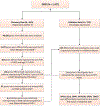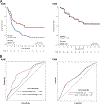African American Specific Gene Panel Predictive of Poor Prostate Cancer Outcome
- PMID: 31107158
- PMCID: PMC7882398
- DOI: 10.1097/JU.0000000000000193
African American Specific Gene Panel Predictive of Poor Prostate Cancer Outcome
Abstract
Purpose: Most prostate cancer in African American men lacks the ETS (E26 transforming specific) family fusion event (ETS-). We aimed to establish clinically relevant biomarkers in African American men by studying ETS dependent gene expression patterns to identified race specific genes predictive of outcomes.
Materials and methods: Two multicenter cohorts of a total of 1,427 men were used for the discovery and validation (635 and 792 men, respectively) of race specific predictive biomarkers. We used false discovery rate adjusted q values to identify race and ETS dependent genes which were differentially expressed in African American men who experienced biochemical recurrence within 5 years. Principal component modeling along with survival analysis was done to assess the accuracy of the gene panel in predicting recurrence.
Results: We identified 3,047 genes which were differentially expressed based on ETS status. Of these genes 362 were differentially expressed in a race specific manner (false discovery rate 0.025 or less). A total of 81 genes were race specific and over expressed in African American men who experienced biochemical recurrence. The final gene panel included APOD, BCL6, EMP1, MYADM, SRGN and TIMP3. These genes were associated with 5-year biochemical recurrence (HR 1.97, 95% CI 1.27-3.06, p = 0.002) and they improved the predictive accuracy of clinicopathological variables only in African American men (60-month time dependent AUC 0.72).
Conclusions: In an effort to elucidate biological features associated with prostate cancer aggressiveness in African American men we identified ETS dependent biomarkers predicting early onset biochemical recurrence only in African American men. Thus, these ETS dependent biomarkers representing ideal candidates for biomarkers of aggressive disease in this patient population.
Keywords: African Americans; biomarkers; gene expression regulation; local; neoplasm recurrence; neoplastic; prostatic neoplasms; tumor.
Figures



Comment in
-
Editorial Comment.J Urol. 2019 Aug;202(2):254. doi: 10.1097/01.JU.0000559946.32495.63. Epub 2019 Jul 8. J Urol. 2019. PMID: 31107156 No abstract available.
-
Editorial Comment.J Urol. 2019 Aug;202(2):254-255. doi: 10.1097/01.JU.0000559947.40119.5a. Epub 2019 Jul 8. J Urol. 2019. PMID: 31107157 No abstract available.
Similar articles
-
A Biopsy-based 17-gene Genomic Prostate Score Predicts Recurrence After Radical Prostatectomy and Adverse Surgical Pathology in a Racially Diverse Population of Men with Clinically Low- and Intermediate-risk Prostate Cancer.Eur Urol. 2015 Jul;68(1):123-31. doi: 10.1016/j.eururo.2014.11.030. Epub 2014 Nov 29. Eur Urol. 2015. PMID: 25465337
-
Novel Biomarker Signature That May Predict Aggressive Disease in African American Men With Prostate Cancer.J Clin Oncol. 2015 Sep 1;33(25):2789-96. doi: 10.1200/JCO.2014.59.8912. Epub 2015 Jul 20. J Clin Oncol. 2015. PMID: 26195723 Free PMC article.
-
Multicenter Comparison of 17-Gene Genomic Prostate Score as a Predictor of Outcomes in African American and Caucasian American Men with Clinically Localized Prostate Cancer.J Urol. 2021 Apr;205(4):1047-1054. doi: 10.1097/JU.0000000000001484. Epub 2020 Dec 1. J Urol. 2021. PMID: 33493001
-
ETS fusion genes in prostate cancer.Endocr Relat Cancer. 2014 May 6;21(3):R143-52. doi: 10.1530/ERC-13-0390. Print 2014 Jun. Endocr Relat Cancer. 2014. PMID: 24659477 Review.
-
[TMPRSS2-ETS gene fusion in prostate cancer].Urologe A. 2007 Jul;46(7):754-60. doi: 10.1007/s00120-007-1347-0. Urologe A. 2007. PMID: 17458530 Review. German.
Cited by
-
Identification and Validation of MYADM as a Novel Prognostic Marker Related to EMT in ESCC.J Cancer. 2024 Aug 19;15(16):5351-5366. doi: 10.7150/jca.88767. eCollection 2024. J Cancer. 2024. PMID: 39247591 Free PMC article.
-
Identification and Validation of a Novel Six-Gene Prognostic Signature of Stem Cell Characteristic in Colon Cancer.Front Oncol. 2021 Feb 19;10:571655. doi: 10.3389/fonc.2020.571655. eCollection 2020. Front Oncol. 2021. PMID: 33680915 Free PMC article.
-
A Comprehensive Bioinformatic Analysis for Identification of Myeloid-Associated Differentiation Marker as a Potential Negative Prognostic Biomarker in Non-Small-Cell Lung Cancer.Pathol Oncol Res. 2022 Aug 19;28:1610504. doi: 10.3389/pore.2022.1610504. eCollection 2022. Pathol Oncol Res. 2022. PMID: 36061144 Free PMC article.
-
Prostate cancers with distinct transcriptional programs in Black and White men.Genome Med. 2024 Jul 23;16(1):92. doi: 10.1186/s13073-024-01361-0. Genome Med. 2024. PMID: 39044302 Free PMC article.
-
Identification of Novel Biomarkers Associated With the Prognosis and Potential Pathogenesis of Breast Cancer via Integrated Bioinformatics Analysis.Technol Cancer Res Treat. 2021 Jan-Dec;20:1533033821992081. doi: 10.1177/1533033821992081. Technol Cancer Res Treat. 2021. PMID: 33550915 Free PMC article.
References
-
- Siegel RL, Miller KD and Jemal A: Cancer statistics, 2017. CA Cancer J Clin 2017; 67: 7. - PubMed
-
- Altekruse SF, Kosary CL, Krapcho M et al.: SEER Cancer Statistics Review. Available at http://seer.cancer.gov/csr/1975_2007/. Accessed September 18, 2017.
-
- Platz EA, Rimm EB, Willett WC et al.: Racial variation in prostate cancer incidence and in hormonal system markers among male health professionals. J Natl Cancer Inst 2000; 92: 2009. - PubMed
Publication types
MeSH terms
Substances
Grants and funding
LinkOut - more resources
Full Text Sources
Medical
Miscellaneous

